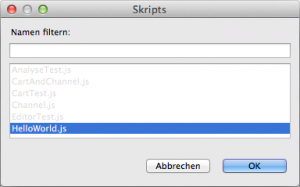
Scripts can automate shelf processing with XPace. Routine activities can then be carried out at the touch of a button, and entire workflows for updating shelves and reporting become child’s play with a good script.
Hello World
As usual in programming, the first step in this article is to show the output of a simple text: The character string “Hello XPace World” is to be output on the XPace console.
Generate script file
Create a text file named HelloWorld.js somewhere on your hard disk. Make sure you have the correct file extension .js! Our suggestion: First create a folder named scripts in the docroot folder of your XPace database, which you can use for all your scripts in the future.
Edit the newly created file with a text editor, e.g. Notepad (Word is not a text editor!). Insert the following source code (without the line numbers):
// write text to console:
Console.writeInfo("Hello XPace World");
The comment line // write text to console: is not important for the execution and can be omitted if desired.
Install and start script
 You can now install the new script in XPace, using
You can now install the new script in XPace, using
Script ➜ Manage Script ➜ Add script
and start it with
Script ➜ Run
The console displays the following output
Hello XPace World *** Ready
Congratulations – you wrote and executed your first script!
Of course, this is only a first introductory example of how to create, install and execute an XPace script. Truly productive scripts that automate planogramming access the objects in a planogram, call up reports and analyses, filter products, change product placement and much more.
The Planogramming API is documented in the XPace Scripting manual.
